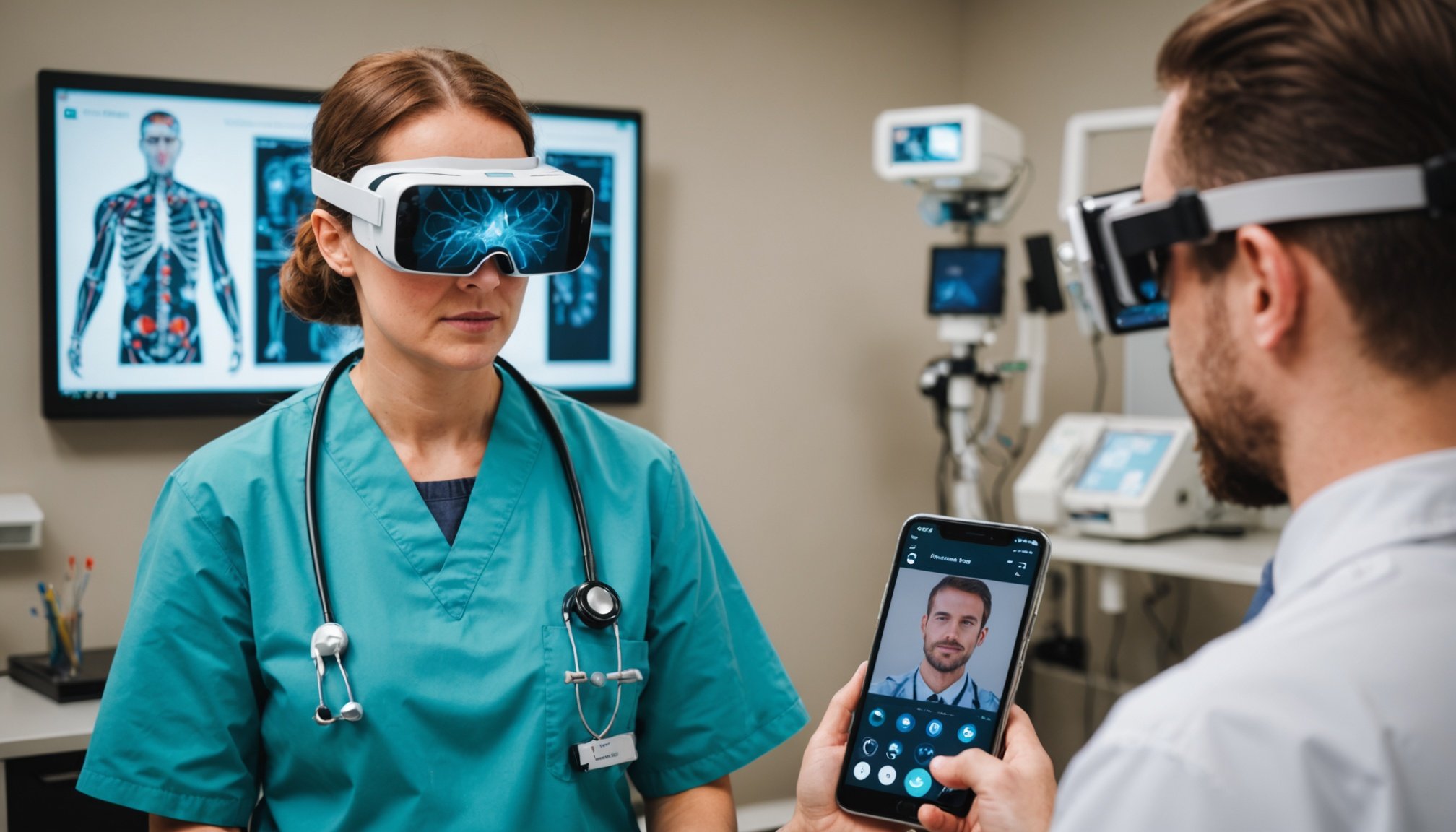Medical training is undergoing a transformative shift, thanks to augmented reality (AR). This technology offers immersive experiences that enhance learning, enabling healthcare professionals to practice complex procedures in a risk-free environment. By integrating AR into training programs, institutions can bridge the gap between theory and practice, ensuring clinicians are better prepared for real-world challenges. Discover how AR is reshaping medical education, leading to improved patient outcomes and more confident practitioners. Embrace the future of healthcare training and explore its countless advantages.
Overview of Augmented Reality in Medical Training
Understanding the transformative potential of technology in healthcare education.
Additional reading : What are the techniques to optimize AI-driven financial forecasting models?
Augmented Reality (AR) is revolutionizing medical training by overlaying digital information onto the physical world, providing immersive learning experiences. Unlike traditional methods, AR allows students to interact with 3D anatomical models, enhancing understanding through visualization. This technology bridges the gap between theoretical knowledge and practical application, crucial in healthcare education.
Historically, the adoption of AR in healthcare began with basic simulations, evolving into sophisticated training tools. The early 2000s saw the integration of AR in surgical training, offering real-time guidance and feedback, which was a significant leap from conventional methods. Today, AR is widely used in medical schools and hospitals, illustrating its growing importance in the field.
Additional reading : Revolutionizing Online Identity Verification: The Role of Blockchain Technology in Streamlining the Process
When comparing AR to traditional medical training methods, several advantages emerge. Traditional methods often rely on textbooks and cadavers, which can be limiting. In contrast, AR provides dynamic, interactive learning environments that adapt to individual learning paces. Here are some key comparisons:
- Traditional Training: Static, limited resources, slower feedback
- Augmented Reality: Interactive, abundant resources, immediate feedback
In summary, the integration of augmented reality into medical training signifies a shift towards more effective, engaging, and comprehensive healthcare education. This evolution not only enhances learning outcomes but also prepares future healthcare professionals for real-world challenges.
Applications of Augmented Reality in Healthcare Education
Exploring the diverse uses and benefits of AR in medical training.
Surgical Training and Simulation
Augmented Reality (AR) is a game-changer in surgical training. By providing real-time overlays of digital information on patients, AR enhances the precision and confidence of surgeons. For instance, AR tools like Microsoft's HoloLens allow trainees to visualize surgical procedures in 3D, offering a dynamic learning experience. This technology not only improves surgical skills but also reduces the risk of errors during operations.
Consider a scenario where a trainee uses AR to practice a complex heart surgery. The AR application provides step-by-step guidance, highlighting critical anatomical structures. This immersive simulation ensures that trainees can rehearse procedures multiple times, gaining valuable experience without patient risk.
Benefits of AR in Surgical Training:
- Enhanced visualization of complex procedures
- Real-time feedback and error correction
- Increased trainee confidence and competence
Anatomy Learning and Visualization
AR revolutionizes anatomy learning by offering interactive 3D models. Students can explore the human body virtually, manipulating organs and systems to understand their functions better. This hands-on approach makes learning more engaging and effective compared to traditional methods.
Patient Interaction and Communication Skills
AR also plays a crucial role in developing patient interaction skills. Simulations with virtual patients help trainees practice communication, empathy, and diagnostic skills in a controlled environment, preparing them for real-world interactions.
Benefits of Augmented Reality for Healthcare Professionals
Exploring the advantages of AR in enhancing medical expertise.
Skill Enhancement and Learning Outcomes
Augmented Reality (AR) offers significant benefits for healthcare professionals, particularly in skill enhancement. By providing immersive, interactive experiences, AR improves learning outcomes and skill retention. Trainees can repeatedly practice procedures in a risk-free environment, which is crucial for mastering complex skills.
Consider a scenario where medical teams use AR to simulate emergency situations. This hands-on practice allows professionals to refine their skills without jeopardizing patient safety.
Opportunities for Hands-On Practice
AR facilitates hands-on practice by offering realistic simulations. This technology enables healthcare professionals to engage in extensive practice sessions, leading to better skill retention. Such opportunities are vital for building confidence and competence in medical procedures.
- Risk-Free Environment: Practice without risk to patients
- Realistic Simulations: Engage in lifelike scenarios
- Repetitive Learning: Enhance retention through repetition
Enhanced Collaboration and Teamwork
AR also fosters collaboration and teamwork in medical settings. By allowing multiple users to interact with the same AR environment, healthcare teams can coordinate more effectively. This collective learning approach enhances communication and team-based problem-solving skills, ultimately improving learning outcomes for all involved.
Challenges and Limitations of Augmented Reality in Medical Training
Navigating the complexities of integrating AR into medical education.
Technical Challenges and Integration
Implementing augmented reality in medical training presents several technical challenges. These include ensuring seamless integration with existing systems and overcoming software compatibility issues. The complexity of creating accurate 3D models and maintaining real-time data processing can be daunting for developers.
Key Technical Challenges:
- Software Compatibility: Ensuring integration with existing platforms
- Data Processing: Managing real-time information flow
- Model Accuracy: Creating precise anatomical representations
Cost and Accessibility Issues
The financial implications of adopting AR technology are significant. High costs of hardware, software development, and maintenance can be barriers for many institutions. Additionally, resource allocation may hinder widespread accessibility, limiting the technology's potential benefits.
Cost Considerations:
- Initial investment in AR equipment
- Ongoing maintenance expenses
- Training costs for educators and students
Acceptance by Educators and Institutions
Resistance from traditional educators poses a barrier to AR adoption. Many educators may be hesitant to adapt to new technologies due to unfamiliarity or skepticism about their effectiveness. Institutions must address these concerns to facilitate a smoother transition.
Educator Concerns:
- Skepticism about AR's educational value
- Need for training and support
- Balancing traditional methods with new technology
Future Trends and Innovations in AR for Healthcare
Exploring the future landscape of augmented reality in medical training.
Predictions for the Evolution of AR in Medical Education
The future of AR in medical education is poised for significant advancements. Experts predict that augmented reality will become more integrated with emerging technologies such as artificial intelligence and machine learning. This integration will enhance the personalization of training programs, adapting to individual learning styles and pacing.
Emerging Technologies Complementing AR
Innovations in medical training are set to expand with the incorporation of emerging technologies. For instance, the use of AI can provide predictive analytics, offering insights into student performance and potential areas for improvement. Additionally, virtual reality (VR) and AR are expected to merge, creating more immersive and comprehensive training environments.
- AI Integration: Personalized learning paths
- VR and AR Fusion: Enhanced immersion
- Predictive Analytics: Performance optimization
Potential Impact on the Future Workforce
The future of AR will significantly impact the healthcare workforce. By equipping professionals with advanced skills and knowledge, AR prepares them for complex medical challenges. This technological shift promises to produce a more competent and confident workforce, capable of delivering high-quality patient care.
"The integration of AR and emerging technologies will revolutionize medical training, empowering the next generation of healthcare professionals."










